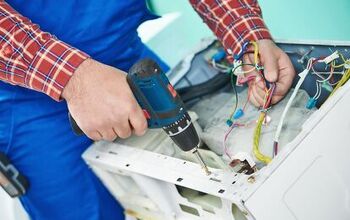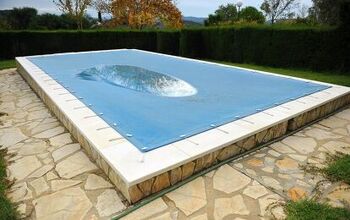What Size Dumpster Do I Need For A Roof? (Find Out Now!)

On average, roofs last about 20 years. However, homeowners with wood shingle or shake roofing may get 30 years out of their roof but asphalt roofs can last as little as 15 years. The lifespan of your roof is also impacted by how severe the weather is in your area. When the time comes to perform extensive repairs or replace the roof completely, it’s important to understand what’s involved in hauling away the waste.
So, you may find yourself wondering: “What size dumpster do I need for a roof?” Generally speaking, the type of materials your roof is made of and the size of your roof will determine what size dumpster you need. Although the most common size dumpster for roofing is the 10-yard container, depending on the aforementioned factors, you may need a dumpster as big as 40 yards.
That said, let’s take a deeper look at why it’s important to understand roofing shingle types and how to calculate the weight of shingle debris in order to pick the right size dumpster for your roof.
Do You Need a Dumpster Rental Service?
Get free, zero-commitment quotes from pro contractors near you.

Calculating the Weight of Shingle Debris
When it comes to replacing a shingle roof, estimating the weight of the debris produced during the process is crucial to keeping the costs of disposal at a minimum. Shingle debris is densely packed and can be exceptionally heavy. If you don’t plan accordingly, you could end up paying some pretty hefty overweight charges.
To calculate the weight of your roof debris, you’ll want to multiply the shingle weight per square by the number of shingle layers by the size of your roof and then add any additional debris. Navigate the information below in order to figure out how much your roofing debris will weigh so that you can choose the ideal size dumpster for disposal.
Understanding Shingle Weight
One approach to obtain a rough estimate of the total weight of your old shingles is to determine the weight of the new shingles you are replacing them with. Simply multiply the weight of a single bundle of shingles by the total number of bundles you purchase for the job to get your estimate.
- Weight of 1 Shingle Bundle x Total Number of Bundles x Number of Shingle Layers = Estimated Total Weight of Shingle Debris
Keep in mind that the estimate you get will likely be higher than the actual weight of the debris since your old shingles have probably lost some granules over time, causing them to weigh less. Though, it’s always better to overestimate the weight of roofing debris than underestimate.
Most shingle bundles weigh between 50 and 80 pounds, but the weight can vary based on the style, type, and quality of the shingle. The following table outlines the average weight for some of the most common types of shingles used on homes:
| Type of Shingle | Weight per Square (lbs.) |
| 3-Tab Shingles | 50 to 65 lbs. per bundle |
| Architectural Shingles | 65 to 80 lbs. per bundle |
Roof Size
The next important factor in determining the weight of your shingle debris is the size of your roof, or the square footage. You can determine roof size by measuring the width and length of each face and then adding them all together for the total square footage of the roof. This process is relatively straightforward for simple roof designs, like gable, hip, and flat roofs.
Though, the more complex your roof is, the more difficult it will be to measure. Once you figure out the square footage of your roof, you can use this measurement to determine the total weight of shingle debris and, thus, the ideal dumpster size for disposal.
Consider Shingle Layers
It’s not uncommon for homes to have multiple layers of shingles on their roofs. With that said, it is crucial that you do not forget to include this in your equation when you’re estimating the weight of the roofing debris. If your roof has two layers of shingles, simply multiply the debris weight by two; three layers by three; and so on.
If you are removing dimensional shingles, there likely aren’t any layers. In most cases, having multiple layers will typically only apply with 3-tab shingles. Though, you can always check be tearing off a small section of shingles before you order the dumpster.
Choosing the Right Size Dumpster
Once you know how much debris you’ll be dealing with and the size of your roof, you’ll be able to make an informed decision on the proper size dumpster to dispose of it. In most cases, either a 10- or 20-yard dumpster will be sufficient. Though, it’s important to note, that while a 10-yard dumpster may be physically big enough, it may not be able to accommodate the weight.
The following chart is an excellent reference for determining what size dumpster you need for your roofing project:
| Roof Size | Weight of Debris | Recommended Dumpster Size |
| 15 square feet | 3,750 to 6,000 lbs. | 10 yard |
| 20 square feet | 5,000 to 8,000 lbs. | 20 yard |
| 25 square feet | 6,250 to 10,000 lbs. | 20 yard |
| 30 square feet | 7,500 to 12,000 lbs. | 30 yard |
| 40 square feet | 10,000 to 16,000 lbs. | 40 yard |
| 50 square feet | 12,500 to 20,000 lbs. | 2 x 30 yard |
| 60 square feet | 15,000 to 24,000 lbs. | 2 x 30 yard |
Additional Considerations
When disposing of roofing shingles, there are typically additional wastes that will be disposed along with them, such as nails and waterproofing materials. While the weight of these items probably won’t make a huge impact on the total weight of the debris load, there are other materials that could add quite a bit of weight.
For example, if you have damaged plywood decking that needs to be disposed of as well, this will add considerable weight and volume to your dumpster. Flashing and gutters will also add weight to the load. So, make sure that you consider the weight of all the items that you plan to dispose of before you choose a dumpsters size.
Note: Some dumpster rental companies require ‘clean loading’ of the roofing shingles. This means that only the shingles and no other debris is allowed in the dumpster. Make sure you inquire about this when you’re going through the rental process.
Roofing Dumpster Costs
Roofing dumpster rentals cost an average of $279 to $487 per week, depending on the container you choose and your location. Though, since shingles and other roofing materials are exceptionally heavy, renting a dumpster is often more cost-effective than taking care of the disposal yourself.
The following table outlines the average cost of the most common roofing dumpster sizes:
| Dumpster Size | Average Cost Range | Weight Limit |
| 10 Yard Container | $220 to $580 | 2 to 3 tons |
| 15 Yard Container | $265 to $620 | 2 to 3 tons (additional room for bulky items) |
| 20 Yard Container | $280 to $699 | 3 tons |
| 30 Yard Container | $311 to $718 | 3 to 5 tons |
| 40 Yard Container | $350 to $780 | 5 to 6 tons |
Do You Need a Dumpster Rental Service?
Get free, zero-commitment quotes from pro contractors near you.

Consider Recycling Shingles
Believe it or not, in most cities, it’s more expensive to dispose of asphalt shingles at a landfill than it is to recycle them at a local recycling facility. The shingles are melted down and the repurposed in asphalt road mixes, the production of new shingles, and more. Recycling costs will depend on where you live.
For instance, in Chicago, it is completely free to clean load asphalt at a Clean Construction and Demolition Debris (CCDD) facility. Whereas, the Scholl Canyon Landfill in Glendale, California charges $30 per ton of clean asphalt shingles but $54 per ton for general municipal waste.
In other words, by making the effort to clean-load your asphalt shingles in your dumpster, you could save a considerable amount of money.

Jessica considers herself a home improvement and design enthusiast. She grew up surrounded by constant home improvement projects and owes most of what she knows to helping her dad renovate her childhood home. Being a Los Angeles resident, Jessica spends a lot of her time looking for her next DIY project and sharing her love for home design.
More by Jessica Stone



























